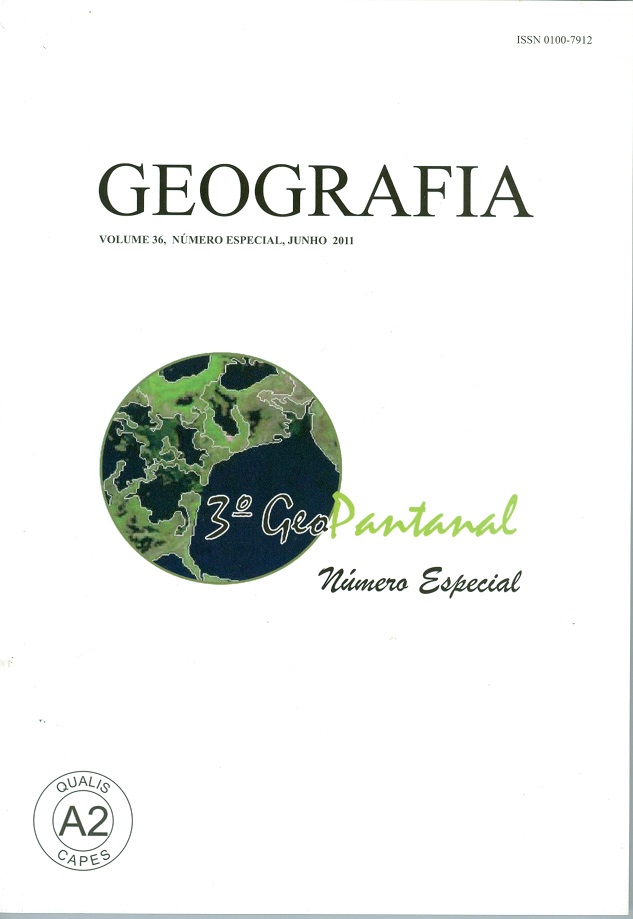TEMPORAL ANALYSIS OF THE USE AND VEGETAL COVERAGE AND THE HONEY POLLEN DIVERSITY IN CÁCERES (MT)
Abstract
This study was conducted to evaluate the influence of the use dynamics and the vegetation cover during the years 2005, 2006, 2008 and 2009 on vegetal diversity as well as its influence on pollen types found in honey of Apis mellifera during two periods, in Cáceres- Mato Grosso State. The use and vegetation cover were analyzed, using the software SPRING and ArcGIS. The collection of both honey and flowers were monthly sampled during the periods from July/2005 to June/2006 and January/2008 to October/2009 in a commercial apiary located in Cáceres. Both qualitative and quantitative analyses of the pollen grains were accomplished in 98 honey slides. The diversity of the pollens was compared between crop and non-crop cycles, using the similarity coefficient. The honey samples were similar between crop cycles/2008 and crop/2005 (Ss=0,29) and between the crops cycles and crop/2008 (Ss=0,35). The crop/2009 was not similar to other periods. The important species for honey were Cecropia pachystachya, Mimosa pudica and Myracrodruon urundeuva, which were not affected both by the use dynamics and vegetation cover. The temporal dynamics of the use and vegetation cover caused low variation in the human-affected and Savannah areas, unlike pollen diversity of the honey which was similar in this research. Key words: Apis mellifera. Vegetation species. Temporality. Geographic Information System. Geo-Technologies. Análise temporal do uso e cobertura vegetal e a diversidade polínica do mel em Cáceres (MT) Objetivou-se avaliar a influência da dinâmica do uso e a cobertura vegetal nos anos de 2005, 2006, 2008 e 2009 sobre a diversidade de plantas e a influência de ambos sobre os tipos polínicos encontrados no mel de Apis mellifera L. em dois períodos em Cáceres (MT). O uso e cobertura vegetal foi realizado por meio da utilização dos SIGs SPRING e ArcGIS. As coletas de méis e flores foram amostradas mensalmente em um apiário comercial em Cáceres, de julho/2005 a junho/2006, janeiro/2008 a outubro/2009. As análises qualitativas e quantitativas dos grãos de pólen foram realizadas em 98 lâminas de méis. A diversidade de pólens foi comparada entre safra e entressafra por meio do índice de similaridade. A similaridade nos méis ocorreu entre a safra/2005 e a entressafra/2006 (Ss=0,29) e entre a entressafra e a safra/2008 (Ss=0,35). A safra/2009 não foi similar aos outros períodos. As espécies importantes para o mel foram Cecropia pachystachya, Mimosa pudica e Myracrodruon urundeuva, as quais não foram influenciadas pela dinâmica do uso e a cobertura vegetal. A dinâmica temporal do uso e cobertura vegetal ocasionou pouca variação nas áreas antrópicas e de Savana, ao contrário da diversidade polínica do mel que foi similar nessa pesquisa. Palavras-chave: Apis mellifera. Espécies vegetais. Temporalidade. Sistema de informação geográfica. Geotecnologias.Downloads
Published
Issue
Section
License
The authors maintain the copyright and grant GEOGRAFIA the right of first publication, with the articles simultaneously licensed under the Creative Commons BY 4.0 License, which allows sharing and adapting the articles for any purpose, as long as appropriate credits and provisions of image rights, privacy or moral rights. Other legal attributions can be accessed at: https://creativecommons.org/licenses/by/4.0/legalcode.en.
Geography, Rio Claro, SP, Brazil - eISSN 1983-8700 is licensed under the Creative Commons BY 4.0 License.





